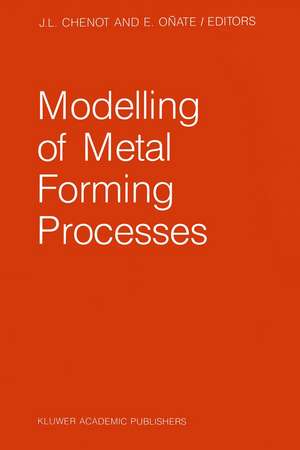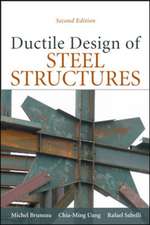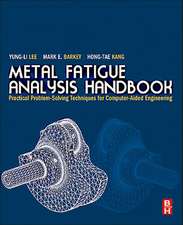Modelling of Metal Forming Processes: Proceedings of the Euromech 233 Colloquium, Sophia Antipolis, France, August 29–31, 1988
Editat de J.L. Chenot, E. Oñateen Limba Engleză Paperback – 22 sep 2011
Preț: 391.79 lei
Nou
Puncte Express: 588
Preț estimativ în valută:
74.97€ • 80.17$ • 62.51£
74.97€ • 80.17$ • 62.51£
Carte tipărită la comandă
Livrare economică 18 aprilie-02 mai
Preluare comenzi: 021 569.72.76
Specificații
ISBN-13: 9789401071314
ISBN-10: 9401071314
Pagini: 360
Ilustrații: IX, 345 p.
Dimensiuni: 160 x 240 x 19 mm
Greutate: 0.5 kg
Ediția:Softcover reprint of the original 1st ed. 1988
Editura: SPRINGER NETHERLANDS
Colecția Springer
Locul publicării:Dordrecht, Netherlands
ISBN-10: 9401071314
Pagini: 360
Ilustrații: IX, 345 p.
Dimensiuni: 160 x 240 x 19 mm
Greutate: 0.5 kg
Ediția:Softcover reprint of the original 1st ed. 1988
Editura: SPRINGER NETHERLANDS
Colecția Springer
Locul publicării:Dordrecht, Netherlands
Public țintă
ResearchCuprins
1: MATERIAL BEHAVIOUR.- The description of yield surfaces for cold prestressed metals with the hypothesis of the isotropy centers translation.- Constitutive description and numerical approach in modelling for metal forming processes.- Simulation of impact tension deformation of metals by FEM.- Finite elements analysis of large plastic deformation in metals.- Modelling of structure formation and relation to mechanical properties of nodular cast iron.- 2: NUMERICAL TECHNIQUES.- H and P mesh refinement in the metal forming FEM analysis.- A mixed Eulerian- Lagrangian FEM for simulation of thermo-mechanical forming processes.- A method to reduce cost of mesh deformation in Eulerian- Lagrangian formulation.- Error control, mesh updating schemes and automatic adaptive remeshing for finite element analysis of unsteady extrusion processes.- Modelling of frictional tool surfaces in finite element metalforming analyses.- Numerical modelling of friction for metal forming processes.- 3: SHEET METAL FORMING.- Modelling of deep drawing processes by model testing and dimensional analysis.- A finite difference model as a basis for developing new constitutive equations for the sheet forming process.- Influence of anisotropy in sheet metal forming.- Experience with explicit and implicit finite element programs for sheet forming analysis.- Influence of thickness and curvature on the formability of metal sheets.- Experimental analysis of an axisymmetric deep drawing.- Computer aided design of a progressive die.- Finite element analysis of sheet metal forming problems using a viscous voided shell formulation.- Time stepping schemes for the numerical analysis of superplastic forming of thin sheet.- Thin sheet forming numerical analysis with a membrane approach.- 4: FORGING AND DRAWING.- Comparison of simulation techniques and industrial data in forging applications.- Finite Element calculation of hot forging with continuous remeshing.- Finite element applications in forming billet and P/M preforms.- Three dimensional finite element calculation of the forging of a connecting rod.- numerical identification of forging parameters.- Identification of defect locations in metal forming using a personal computer oriented finite element method.- Modelling of metal forming processes.- Numerical analysis of cold drawing of tubes.- 5: HOT AND COLD ROLLING.- A 3D thermomechanical analysis of steady flows in hot forming processes. Application to hot flat rolling and hot shape rolling.- Thermal-mechanical modelling for hot rolling: experimental substantiation.- Simulation of hot rolling of steel by plasticine or waxes. Comparison between the flow of steel and the flow of plasticine by actual rolling and finite element models.- Simulation of profile and flatness in the cold rolling of steel strip.- Application of a mathematical model for the cold rolling process on six-high mills.- Analysis of plane strain cold rolling using a flow function and the weighted residuals method.- Metallographic verification of computer modelling of hot rolling.- Finite element analysis of two-roll hot piercing.- Modelling the mechanics of the longitudinal tube rolling process.








